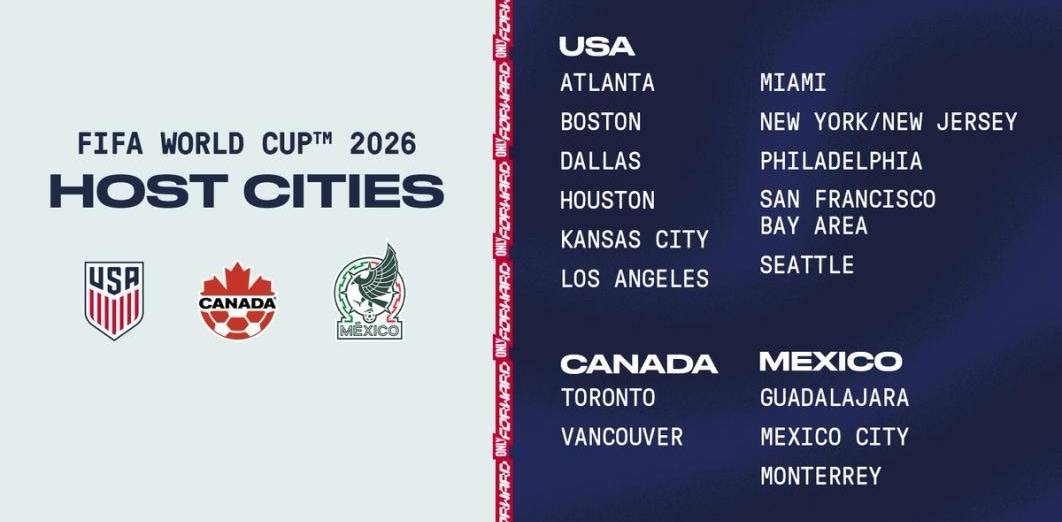Could the FIFA World Cup land in the Caribbean?
How new host destinations are paving the way for emerging markets
Whatsup Squad,
The FIFA Men’s World Cup is the most watched sporting event in the world, and FIFA just confirmed the host destinations for 2030 and 2034.
The announcement not only sets the stage for the next 10 years, but it also suggests what the next 30 years might look like.
North America to Host 2026 World Cup
We’ve known for some time that the 2026 World Cup will be jointly hosted by Canada, Mexico, and the United States.
The World Cup is traditionally hosted by one country, but FIFA's decision to expand the tournament to 48 teams (up from 32 teams) has made this nearly impossible.
The 2026 edition will be the first World Cup hosted by three nations and the first since 2002 to be hosted by more than one nation.
The tournament will be spread out across 16 cities, meaning more traveling soccer fans.
Canada will host 13 matches, which is expected to contribute up to $2.7 billion to the economy while creating 24,100 jobs.
In Mexico, which will also host 13 matches, the tournament is expected to attract 5 million visitors and inject $3 billion into the economy.
Mexico and Canada would not be able to host the expanded World Cup on their own, but the joint bid allows the United States to host 78 of the 104 matches while these countries still create thousands of jobs and generate billions of dollars in economic impact.
6 Nations to Host 2030 World Cup
The 2030 World Cup will be hosted across six nations and two continents.
Morocco, Spain, and Portugal will serve as the main hosts, with the first three matches of that tournament held in Uruguay, Argentina and Paraguay.
This will make Morocco only the second African nation to host the World Cup, following South Africa in 2010.
For Africa, Morocco’s co-hosting role represents a moment of progress and showcases the continent’s ability to stage world-class events.
For emerging markets, it reinforces FIFA’s commitment to uniting cultures and expanding football’s reach.
Saudi Arabia to Host 2034 World Cup
This week, Saudi Arabia was confirmed as the host of the 2034 World Cup.
As part of Saudi Vision 2030, the kingdom has invested billions in sports as it tries to diversify away from oil.
When their vision was first announced in 2016, few could have imagined that they would go on to host the most popular sporting event in the world.
The host destinations for 2026, 2030, and 2034 hint at opportunities for smaller nations beyond the next decade.
Opportunity in the Caribbean
In the Caribbean, the main sticking point is stadiums and infrastructure.
Neglecting these facilities could limit the region’s ability to compete on the global stage.
FIFA has strict stadium guideline requirements:
To host a group-stage match, stadiums must have a capacity of at least 40,000
To host a quarter-finals or semi-finals match, stadiums must have a capacity of at least 60,000
To host the opening ceremony or final, stadiums must have a capacity of at least 80,000
Hosts are also required to have enough hotels to support the rapid influx of visitors.
That said, FIFA only requires stadiums to have a capacity of 20,000 for the Women’s World Cup.
With the largest stadium, and the highest ranked team, a joint bid to host the Women’s World Cup must be led by Jamaica.
Obviously, they cannot do it alone. That’s where the UK comes in.
Countries like Jamaica and Trinidad (former British colonies) could each host a handful of group-stage matches as part of a joint bid with England (and even Scotland, Ireland, and Wales).
Along with fielding one of the top women’s teams in the world, England has the infrastructure to satisfy FIFA’s requirements and host the lion’s share of the tournament.
And Jamaica’s team is no slouch either.
Despite a lack of funding, the Reggae Girlz qualified for their first World Cup in 2019 and achieved their first World Cup win in 2023.
They also have Bunny Shaw — arguably the best female player in the world.
That is, women’s soccer in Jamaica is trending in the right direction.
And now is not the time to be satisfied. It’s time to double down.
Final Thoughts
The next hosts for the FIFA Men’s World Cup suggest a bright future for emerging markets.
The expanded tournament makes it harder for one nation to host the entire event, so we should expect to see more joint bids in the future.
For now, the focus in the Caribbean should be on competing at the highest level, igniting increased interest and investment in the sport.
But looking ahead, we need to plan for the long-term.
Saudi Arabia has Saudi Vision 2030. In the Caribbean, the Women’s World Cup should be the north star.
It won’t happen overnight, or even the next 10 years, but why not start planning for the next 30?
If you enjoyed this breakdown, share it with one friend who might like it too.
Until next time ✌🏾








